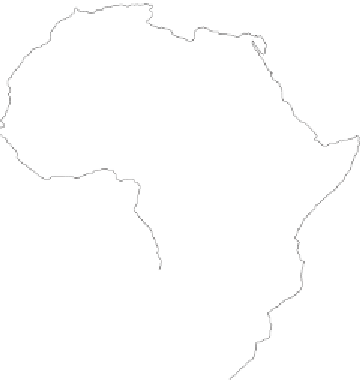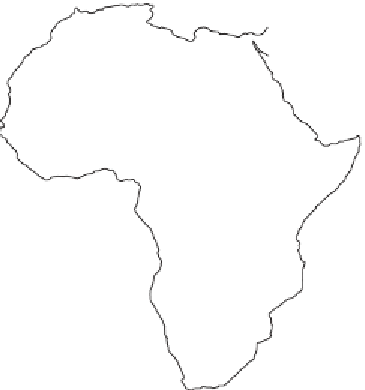Geoscience Reference
In-Depth Information
Figure 18.1. Mean annual precipitation in Africa. (After
The Times Atlas of Africa
,
2010.)
18.2 Present environment
The major elements of the present environments in this vast region, including climate
and topography, have been described in detail elsewhere (Griffiths,
1972
; Rognon
and Williams,
1977
; Tyson,
1986
; Hastenrath,
1991
; Nicholson,
1996
; Gasse et al.,
2008
; Nicholson,
2011
). So too have the fundamental causes of aridity (
Chapter 2
).
Only a brief summary is therefore needed here. The topography of Africa and Arabia
plays an important role in regional climate. The great escarpments of southern Africa
and southern Arabia-Yemen-Oman and the highlands of Ethiopia, Kenya and Uganda
generate orographic rain and create rain shadows on their leeward sides, accentuating
aridity in the lowlands downwind (
Figure 18.1
). Seasonal migration of wind and
pressure belts (
Figure 18.2
), especially the Intertropical Convergence Zone (ITCZ) in
the seasonally wet tropics and the westerlies in the winter rainfall regions of south-
west and north-west Africa, determine the amount and pattern of summer and winter
precipitation in both northern and southern deserts and their margins. As a very broad
generalisation, the western half of Africa receives most of its rain from the Atlantic and
the eastern half from the Indian Ocean, although certain areas, such as the Ugandan
headwaters of the White Nile, receive rain from both sources. The southern Sahara
receives summer rainfall from the Atlantic in the west and from the Indian Ocean
in the east. There are occasional inputs from winter depressions, such as along the
Atlantic coast of the Sahara and along the Red Sea. These can bring exceptionally
heavy rainfall, as in the central Mauritanian desert in January 2004 and in the northern
Red Sea and Dead Sea Rift in November 2009.








































